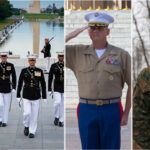The National Guard Dress Uniform is a symbol of pride, professionalism, and readiness, representing a rich history and commitment to service. Understanding the nuances of this uniform, from its components to wear regulations, is crucial for National Guard personnel and anyone interested in military attire. This guide provides a comprehensive overview of the National Guard dress uniform, ensuring clarity and offering valuable insights into this distinguished attire.
Understanding the Significance of the Dress Uniform
The dress uniform is more than just clothing; it embodies the values and traditions of the National Guard. Worn during formal occasions, ceremonies, and official functions, it projects an image of discipline and honor. Each element of the uniform, from the jacket to the accoutrements, carries specific meaning and adheres to strict regulations, reflecting the wearer’s dedication and service.
Components of the National Guard Dress Uniform
The National Guard dress uniform, while sharing similarities with other branches of the U.S. military, has its own distinct characteristics. Let’s break down the key components:
Dress Coat and Trousers
The dress coat is the centerpiece of the uniform, typically a dark blue or Army blue shade for Army National Guard and a similar style but potentially different shade for Air National Guard. The cut and style are designed for a sharp, professional appearance. Trousers are coordinated with the coat, maintaining a consistent formal look. The fit and tailoring are crucial for presenting a smart and well-maintained appearance, adhering to military standards of grooming and uniform wear.
Dress Shirt and Neckwear
Worn under the dress coat, the dress shirt is usually white, contributing to the crisp and formal aesthetic. For Army National Guard, a black bow tie is often required for certain dress uniform configurations, enhancing the formality. The Air National Guard might utilize a different style of neckwear depending on the specific dress uniform variant.
Footwear and Headgear
Black dress shoes or dress boots, highly polished, are mandatory, completing the formal look from head to toe. Headgear varies depending on the specific dress uniform and branch. For Army National Guard, this could include the service cap or garrison cap. Air National Guard personnel may wear a service cap or flight cap, again depending on the occasion and uniform type. The precise headgear and footwear are dictated by uniform regulations to ensure uniformity and adherence to standards.
Accoutrements: Ribbons, Medals, and Insignia
Accoutrements are the details that truly personalize and distinguish the dress uniform. Ribbons and medals, earned through service and achievement, are proudly displayed, narrating the individual’s military journey. Insignia, denoting rank and branch, are meticulously placed according to regulations. The arrangement and display of these elements are strictly governed, ensuring uniformity and respect for the awards and achievements they represent. Understanding the correct placement and order of precedence for ribbons and medals is a key aspect of wearing the dress uniform properly.
Occasions for Wearing the Dress Uniform
The National Guard dress uniform is reserved for specific formal occasions that demand the highest standards of military presentation. These occasions typically include:
- Formal Ceremonies: Change of command ceremonies, award presentations, and military parades are prime examples where the dress uniform is mandated.
- Official Social Functions: Formal dinners, balls, and receptions associated with military events often require dress uniform attire.
- Funerals and Memorial Services: Wearing the dress uniform at military funerals and memorial services is a mark of respect and honor for fallen comrades.
- Special Parades and Reviews: Certain parades, particularly those of a ceremonial nature or military reviews, call for the dress uniform.
- Recruiting Events (Officer/NCO Representation): In specific recruiting scenarios, senior personnel may wear the dress uniform to project professionalism and inspire potential recruits.
The specific type of dress uniform (e.g., full dress, mess dress) worn will further depend on the formality of the event and be outlined in military orders or invitations.
Regulations and Guidelines
Wearing the National Guard dress uniform is governed by stringent regulations outlined in official military publications. These regulations cover every aspect of the uniform, including:
- Proper Fit and Wear: Uniforms must be properly fitted and maintained in immaculate condition.
- Grooming Standards: Haircuts, shaving, and overall personal grooming must adhere to military standards to complement the uniform.
- Accoutrement Placement: Precise rules dictate the placement of ribbons, medals, insignia, and other adornments.
- Authorized Combinations: Regulations specify which components are authorized for different types of dress uniforms and occasions.
- Maintenance and Care: Guidelines exist for cleaning, pressing, and storing the uniform to preserve its condition and appearance.
National Guard personnel are responsible for being thoroughly familiar with these regulations and ensuring their uniform meets all requirements. Resources like the Army Regulation 670-1 (for Army National Guard, although specific NG supplements may exist) and Air Force Instruction 36-2903 (for Air National Guard) provide detailed guidance.
Maintaining Your Dress Uniform
Proper maintenance is essential to keep the dress uniform in pristine condition. This includes:
- Regular Cleaning: Dry cleaning is typically recommended for the dress coat and trousers to maintain the fabric and shape.
- Careful Storage: Using garment bags and proper hangers prevents damage and wrinkles.
- Polishing Shoes and Buckles: Maintaining a high shine on shoes and belt buckles is crucial for a sharp appearance.
- Inspecting for Wear and Tear: Regularly check for loose buttons, fraying fabric, or other signs of wear and address them promptly.
A well-maintained dress uniform reflects pride in oneself and the National Guard.
Conclusion
The National Guard dress uniform is a powerful symbol of service, tradition, and professionalism. By understanding its components, occasions for wear, and regulations, National Guard members uphold the high standards associated with this distinguished attire. For those outside the military, appreciating the significance of the dress uniform offers a deeper understanding of the dedication and commitment of National Guard personnel. Wearing this uniform is not just about adhering to rules; it’s about embodying the honor and values of the National Guard.

